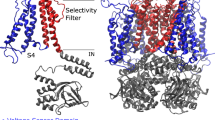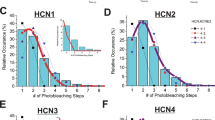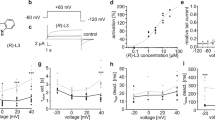Abstract
hERG potassium channels are essential for normal electrical activity in the heart. Inherited mutations in the HERG gene cause long QT syndrome, a disorder that predisposes individuals to life-threatening arrhythmias. Arrhythmia can also be induced by a blockage of hERG channels by a surprisingly diverse group of drugs. This side effect is a common reason for drug failure in preclinical safety trials. Insights gained from the crystal structures of other potassium channels have helped our understanding of the block of hERG channels and the mechanisms of gating.
This is a preview of subscription content, access via your institution
Access options
Subscribe to this journal
Receive 51 print issues and online access
$199.00 per year
only $3.90 per issue
Buy this article
- Purchase on Springer Link
- Instant access to full article PDF
Prices may be subject to local taxes which are calculated during checkout





Similar content being viewed by others
References
Warmke, J. W. & Ganetzky, B. A family of potassium channel genes related to eag in Drosophila and mammals. Proc. Natl Acad. Sci. USA 91, 3438–3442 (1994).
Curran, M. E. et al. A molecular basis for cardiac arrhythmia: HERG mutations cause long QT syndrome. Cell 80, 795–803 (1995).
Haverkamp, W. et al. The potential for QT prolongation and proarrhythmia by non-antiarrhythmic drugs: clinical and regulatory implications. Report on a policy conference of the European Society of Cardiology. Eur. Heart J. 21, 1216–1231 (2000).
Doyle, D. A. et al. The structure of the potassium channel: molecular basis of K+ conduction and selectivity. Science 280, 69–77 (1998).
Jiang, Y. et al. Crystal structure and mechanism of a calcium-gated potassium channel. Nature 417, 515–522 (2002).
Jiang, Y. et al. X-ray structure of a voltage-dependent K+ channel. Nature 423, 33–41 (2003).
Long, S. B., Campbell, E. B. & MacKinnon, R. Crystal structure of a mammalian voltage-dependent Shaker family K+ channel. Science 309, 897–903 (2005).
Farrelly, A. M. et al. Expression and function of KCNH2 (HERG) in the human jejunum. Am. J. Physiol. 284, G883–G895 (2003).
Chiesa, N., Rosati, B., Arcangeli, A., Olivotto, M. & Wanke, E. A novel role for HERG K+ channels: spike-frequency adaptation. J. Physiol. (Lond.) 501, 313–318 (1997).
Smith, G. A. et al. Functional up-regulation of HERG K+ channels in neoplastic hematopoietic cells. J. Biol. Chem. 277, 18528–18534 (2002).
Shi, W. et al. Identification of two nervous system-specific members of the erg potassium channel gene family. J. Neurosci. 17, 9423–9432 (1997).
Wimmers, S., Wulfsen, I., Bauer, C. K. & Schwarz, J. R. Erg1, erg2 and erg3 K channel subunits are able to form heteromultimers. Pflugers Arch. 441, 450–455 (2001).
Sanguinetti, M. C., Jiang, C., Curran, M. E. & Keating, M. T. A mechanistic link between an inherited and an acquired cardiac arrhythmia: HERG encodes the IKr potassium channel. Cell 81, 299–307 (1995).
Trudeau, M., Warmke, J. W., Ganetzky, B. & Robertson, G. A. HERG, a human inward rectifier in the voltage-gated potassium channel family. Science 269, 92–95 (1995).
Bennett, P. B., Yazawa, K., Makita, N. & George, A. L. Molecular mechanism for an inherited cardiac arrhythmia. Nature 376, 683–685 (1995).
Plaster, N. M. et al. Mutations in Kir2.1 cause the developmental and episodic electrical phenotypes of Andersen's syndrome. Cell 105, 511–519 (2001).
Splawski, I. et al. CaV1.2 calcium channel dysfunction causes a multisystem disorder including arrhythmia and autism. Cell 119, 19–31 (2004).
Furutani, M. et al. Novel mechanism associated with an inherited cardiac arrhythmia: defective protein trafficking by the mutant HERG (G601S) potassium channel. Circulation 99, 2290–2294 (1999).
Delisle, B. P., Anson, B. D., Rajamani, S. & January, C. T. Biology of cardiac arrhythmias: ion channel protein trafficking. Circ. Res. 94, 1418–1428 (2004).
Gong, Q., Keeney, D. R., Molinari, M. & Zhou, Z. Degradation of trafficking-defective long QT syndrome type II mutant channels by the ubiquitin–proteasome pathway. J. Biol. Chem. 280, 19419–19425 (2005).
Sanguinetti, M. C., Curran, M. E., Spector, P. S. & Keating, M. T. Spectrum of HERG K+ channel dysfunction in an inherited cardiac arrhythmia. Proc. Natl Acad. Sci. USA 93, 2208–2212 (1996).
Kagan, A., Yu, Z., Fishman, G. I. & McDonald, T. V. The dominant negative LQT2 mutation A561V reduces wild-type HERG expression. J. Biol. Chem. 275, 11241–11248 (2000).
Nakajima, T. et al. Novel mechanism of HERG current suppression in LQT2: shift in voltage dependence of HERG inactivation. Circ. Res. 83, 415–422 (1998).
Brugada, R. et al. Sudden death associated with short-QT syndrome linked to mutations in HERG. Circulation 109, 30–35 (2004).
Zhou, Y., Morais-Cabral, J. H., Kaufman, A. & MacKinnon, R. Chemistry of ion coordination and hydration revealed by a K+ channel–Fab complex at 2.0 Å resolution. Nature 414, 43–48 (2001).
Jiang, Y., Lee, A., Cadene, M., Chait, B. T. & MacKinnon, R. The open pore conformation of potassium channels. Nature 417, 523–526 (2002).
Long, S. B., Campbell, E. B. & MacKinnon, R. Voltage sensor of Kv1.2: structural basis of electromechanical coupling. Science 309, 903–908 (2005).
Mitcheson, J. S., Chen, J., Lin, M., Culberson, C. & Sanguinetti, M. C. A structural basis for drug-induced long QT syndrome. Proc. Natl Acad. Sci. USA 97, 12329–12333 (2000).
Webster, S. M., Del Camino, D., Dekker, J. P. & Yellen, G. Intracellular gate opening in Shaker K+ channels defined by high-affinity metal bridges. Nature 428, 864–868 (2004).
Fernandez, D., Ghanta, A., Kauffman, G. W. & Sanguinetti, M. C. Physicochemical features of the hERG channel drug binding site. J. Biol. Chem. 279, 10120–10127 (2004).
Morais Cabral, J. H. et al. Crystal structure and functional analysis of the HERG potassium channel N terminus: a eukaryotic PAS domain. Cell 95, 649–655 (1998).
Taylor, B. L. & Zhulin, I. B. PAS domains: internal sensors of oxygen, redox potential, and light. Microbiol. Mol. Biol. Rev. 63, 479–506 (1999).
London, B. et al. Two isoforms of the mouse ether-a-go-go-related gene coassemble to form channels with properties similar to the rapidly activating component of the cardiac delayed rectifier K+ current. Circ. Res. 81, 870–878 (1997).
Cui, J., Melman, Y., Palma, E., Fishman, G. I. & McDonald, T. V. Cyclic AMP regulates the HERG K+ channel by dual pathways. Curr. Biol. 10, 671–674 (2000).
Akhavan, A. et al. Identification of the cyclic-nucleotide-binding domain as a conserved determinant of ion-channel cell-surface localization. J. Cell Sci. 118, 2803–2812 (2005).
Barhanin, J. et al. KvLQT1 and IsK (minK) proteins associate to form the IKs cardiac potassium channel. Nature 384, 78–80 (1996).
Sanguinetti, M. C. et al. Coassembly of KvLQT1 and minK (IsK) proteins to form cardiac IKs potassium channel. Nature 384, 80–83 (1996).
Abbott, G. W. et al. MiRP1 forms IKr potassium channels with HERG and is associated with cardiac arrhythmia. Cell 97, 175–187 (1999).
Pourrier, M., Zicha, S., Ehrlich, J., Han, W. & Nattel, S. Canine ventricular KCNE2 expression resides predominantly in Purkinje fibers. Circ. Res. 93, 189–191 (2003).
Lundquist, A. L. et al. Expression of multiple KCNE genes in human heart may enable variable modulation of IKs . J. Mol. Cell. Cardiol. 38, 277–287 (2005).
Weerapura, M., Nattel, S., Chartier, D., Caballero, R. & Hebert, T. E. A comparison of currents carried by HERG, with and without coexpression of MiRP1, and the native rapid delayed rectifier current. Is MiRP1 the missing link? J. Physiol. (Lond.) 540, 15–27. (2002).
Sesti, F. et al. A common polymorphism associated with antibiotic-induced cardiac arrhythmia. Proc. Natl Acad. Sci. USA 97, 10613–10618 (2000).
Noble, D. & Tsien, R. W. Outward membrane currents activated in the plateau range of potentials in cardiac Purkinje fibres. J. Physiol. (Lond.) 200, 205–231 (1969).
Shibasaki, T. Conductance and kinetics of delayed rectifier potassium channels in nodal cells of the rabbit heart. J. Physiol. (Lond.) 387, 227–250 (1987).
Clay, J. R., Hill, C. E., Roitman, D. & Shrier, A. Repolarization current in embryonic chick atrial heart cells. J. Physiol. (Lond.) 403, 525–537 (1988).
Sanguinetti, M. C. & Jurkiewicz, N. K. Two components of cardiac delayed rectifier K+ current: Differential sensitivity to block by class III antiarrhythmic agents. J. Gen. Physiol. 96, 195–215 (1990).
Piper, D. R., Varghese, A., Sanguinetti, M. C. & Tristani-Firouzi, M. Gating currents associated with intramembrane charge displacement in HERG potassium channels. Proc. Natl Acad. Sci. USA 100, 10534–10539 (2003).
Smith, P. L. & Yellen, G. Fast and slow voltage sensor movements in HERG potassium channels. J. Gen. Physiol. 119, 275–293 (2002).
Subbiah, R. N., Kondo, M., Campbell, T. J. & Vandenberg, J. I. Tryptophan scanning mutagenesis of the HERG K+ channel: The S4 domain is loosely packed and likely to be lipid exposed. J. Physiol. (Lond.) 569, 367–379 (2005).
Piper, D. R., Hinz, W. A., Tallurri, C. K., Sanguinetti, M. C. & Tristani-Firouzi, M. Regional specificity of human ether-a'-go-go-related gene channel activation and inactivation gating. J. Biol. Chem. 280, 7206–7217 (2005).
Zhang, M., Liu, J. & Tseng, G. N. Gating charges in the activation and inactivation processes of the HERG channel. J. Gen. Physiol. 124, 703–718 (2004).
Larsson, H. P., Baker, O. S., Dhillon, D. S. & Isacoff, E. Y. Transmembrane movement of the Shaker K+ channel S4. Neuron 16, 387–397 (1996).
Silverman, W. R., Roux, B. & Papazian, D. M. Structural basis of two-stage voltage-dependent activation in K+ channels. Proc. Natl Acad. Sci. USA 100, 2935–2940 (2003).
Liu, J., Zhang, M., Jiang, M. & Tseng, G. N. Negative charges in the transmembrane domains of the HERG K channel are involved in the activation- and deactivation-gating processes. J. Gen. Physiol. 121, 599–614 (2003).
Fernandez, D., Ghanta, A., Kinard, K. I. & Sanguinetti, M. C. Molecular mapping of a site for Cd2+-induced modification of human ether-a-go-go-related gene (hERG) channel activation. J. Physiol. (Lond.) 567, 737–755 (2005).
Laine, M., Papazian, D. M. & Roux, B. Critical assessment of a proposed model of Shaker. FEBS Lett. 564, 257–263 (2004).
Posson, D. J., Ge, P., Miller, C., Bezanilla, F. & Selvin, P. R. Small vertical movement of a K+ channel voltage sensor measured with luminescence energy transfer. Nature 436, 848–851 (2005).
Jiang, Y., Ruta, V., Chen, J., Lee, A. & MacKinnon, R. The principle of gating charge movement in a voltage-dependent K+ channel. Nature 423, 42–48 (2003).
Ruta, V., Chen, J. & MacKinnon, R. Calibrated measurement of gating-charge arginine displacement in the KvAP voltage-dependent K+ channel. Cell 123, 463–475 (2005).
Lu, Z., Klem, A. M. & Ramu, Y. Coupling between voltage sensors and activation gate in voltage-gated K+ channels. J. Gen. Physiol. 120, 663–676. (2002).
Tristani-Firouzi, M., Chen, J. & Sanguinetti, M. C. Interactions between S4–S5 linker and S6 transmembrane domain modulate gating of HERG K+ channels. J. Biol. Chem. 277, 18994–19000 (2002).
Spector, P. S., Curran, M. E., Zou, A., Keating, M. T. & Sanguinetti, M. C. Fast inactivation causes rectification of the IKr channel. J. Gen. Physiol. 107, 611–619 (1996).
Smith, P. L., Baukrowitz, T. & Yellen, G. The inward rectification mechanism of the HERG cardiac potassium channel. Nature 379, 833–836 (1996).
Fan, J.-S., Jinag, M., Dun, W., McDonald, T. V. & Tseng, G.-N. Effects of outer mouth mutations on hERG channel function: A comparison with similar mutations in the Shaker channel. Biophys. J. 76, 3128–3140 (1999).
Baukrowitz, T. & Yellen, G. Modulation of K+ current by frequency and external [K+]: A tale of two inactivation mechanisms. Neuron 15, 951–960 (1995).
Kiss, L. & Korn, S. J. Modulation of C-type inactivation by K+ at the potassium channel selectivity filter. Biophys. J. 74, 1840–1849 (1998).
De Bruin, M. L., Pettersson, M., Meyboom, R. H., Hoes, A. W. & Leufkens, H. G. Anti-HERG activity and the risk of drug-induced arrhythmias and sudden death. Eur. Heart J. 26, 590–597 (2005).
Vitola, J., Vukanovic, J. & Roden, D. M. Cisapride-induced torsades de pointes. J. Cardiovasc. Electrophysiol. 9, 1109–1113 (1998).
Recanatini, M., Poluzzi, E., Masetti, M., Cavalli, A. & De Ponti, F. QT prolongation through hERG K+ channel blockade: current knowledge and strategies for the early prediction during drug development. Med. Res. Rev. 25, 133–166 (2005).
Kuryshev, Y. A. et al. Pentamidine-induced long QT syndrome and block of hERG trafficking. J. Pharmacol. Exp. Ther. 312, 316–323 (2005).
Cavalli, A., Poluzzi, E., De Ponti, F. & Recanatini, M. Toward a pharmacophore for drugs inducing the long QT syndrome: Insights from a CoMFA study of HERG K+ channel blockers. J. Med. Chem. 45, 3844–3853 (2002).
Ekins, S., Crumb, W. J., Sarazan, R. D., Wikel, J. H. & Wrighton, S. A. Three-dimensional quantitative structure–activity relationship for inhibition of human ether-a-go-go-related gene potassium channel. J. Pharmacol. Exp. Ther. 301, 427–434 (2002).
Pearlstein, R. A. et al. Characterization of HERG potassium channel inhibition using CoMSiA 3D QSAR and homology modeling approaches. Bioorg. Med. Chem. Lett. 13, 1829–1835 (2003).
Sanguinetti, M. C. & Mitcheson, J. S. Predicting drug-hERG channel interactions that cause acquired long QT syndrome. Trends Pharmacol. Sci. 26, 119–124 (2005).
Dubin, A. E. et al. Identifying modulators of hERG channel activity using the PatchXpress planar patch clamp. J. Biomol. Screen. 10, 168–181 (2005).
Pearlstein, R., Vaz, R. & Rampe, D. Understanding the structure-activity relationship of the human ether-a-go-go-related gene cardiac K+ channel. A model for bad behavior. J. Med. Chem. 46, 2017–2022 (2003).
Rajamani, R., Tounge, B. A., Li, J. & Reynolds, C. H. A two-state homology model of the hERG K+ channel: application to ligand binding. Bioorg. Med. Chem. Lett. 15, 1737–1741 (2005).
Osterberg, F. & Aqvist, J. Exploring blocker binding to a homology model of the open hERG K+ channel using docking and molecular dynamics methods. FEBS Lett. 579, 2939–2944 (2005).
Lastraioli, E. et al. herg1 gene and HERG1 protein are overexpressed in colorectal cancers and regulate cell invasion of tumor cells. Cancer Res. 64, 606–611 (2004).
Kang, J. et al. Discovery of a small molecule activator of the Human Ether-a-go-go-Related Gene (HERG) cardiac K+ channel. Mol. Pharmacol. 67, 827–836 (2005).
Wang, Q. et al. Positional cloning of a novel potassium channel gene: KVLQT1 mutations cause cardiac arrhythmias. Nature Genetics 12, 17–23 (1996).
Splawski, I., Tristani-Firouzi, M., Lehmann, M. H., Sanguinetti, M. C. & Keating, M. T. Mutations in the hminK gene cause long QT syndrome and suppress IKs function. Nature Genet. 17, 338–340 (1997).
Wang, Q. et al. SCN5A mutations associated with an inherited cardiac arrhythmia, long QT syndrome. Cell 80, 805–811 (1995).
Chen, Q. et al. Genetic basis and molecular mechanism for idiopathic ventricular fibrillation. Nature 392, 293–296 (1998).
Priori, S. G. et al. Mutations in the cardiac ryanodine receptor gene (hRyR2) underlie catecholaminergic polymorphic ventricular tachycardia. Circulation 103, 196–200 (2001).
Priebe, L. & Beuckelmann, D. J. Simulation study of cellular electric properties in heart failure. Circ. Res. 82, 1206–1223 (1998).
Priori, S. G. et al. A novel form of short QT syndrome (SQT3) is caused by a mutation in the KCNJ2 gene. Circ. Res. 96, 800–807 (2005).
Schott, J.-J. et al. Cardiac conduction defects associate with mutations in SCN5A. Nature Genet. 23, 20–21 (1999).
Author information
Authors and Affiliations
Corresponding author
Ethics declarations
Competing interests
The authors declare no competing financial interests.
Additional information
Author Information Reprints and permissions information is available at npg.nature.com/reprintsandpermissions
Rights and permissions
About this article
Cite this article
Sanguinetti, M., Tristani-Firouzi, M. hERG potassium channels and cardiac arrhythmia. Nature 440, 463–469 (2006). https://doi.org/10.1038/nature04710
Published:
Issue Date:
DOI: https://doi.org/10.1038/nature04710
This article is cited by
-
Potassium ion channels as a molecular target to reduce virus infection and mortality of honey bee colonies
Virology Journal (2023)
-
Detecting organelle-specific activity of potassium channels with a DNA nanodevice
Nature Biotechnology (2023)
-
Noncanonical electromechanical coupling paths in cardiac hERG potassium channel
Nature Communications (2023)
-
Toxicity prediction and analysis of flavonoid apigenin as a histone deacetylase inhibitor: an in-silico approach
In Silico Pharmacology (2023)
-
Andrographolide-based potential anti-inflammatory transcription inhibitors against nuclear factor NF-kappa-B p50 subunit (NF-κB p50): an integrated molecular and quantum mechanical approach
3 Biotech (2023)
Comments
By submitting a comment you agree to abide by our Terms and Community Guidelines. If you find something abusive or that does not comply with our terms or guidelines please flag it as inappropriate.



